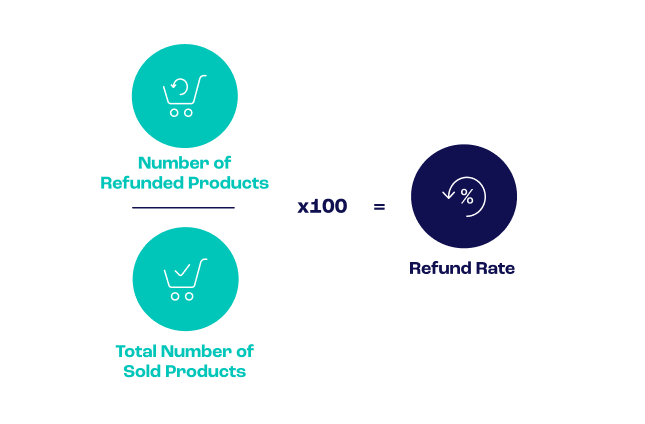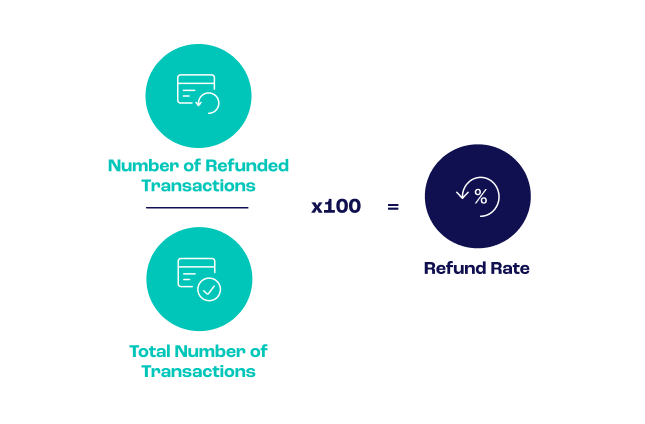What Is the Refund Rate?
The refund rate is a financial and quality assurance metric that retailers use. It relates to the total number of transactions or products that are sold and subsequently refunded.
There are a range of reasons why someone would return a product and ask for a refund, but this can seriously impact the profitability of a business. Invesp reports that consumers return 30% of all products they buy online – compared to 8.89% of goods purchased in traditional bricks and mortar stores.
Consumers may return products because they aren’t quite what they expected, don’t fit or look right, don’t meet the consumer’s quality expectations, or for a variety of other reasons. Regardless of the cause of the return, the retailer loses out in terms of both the lost sale and the operational and financial cost of processing the return and refund.
However, we should note that, when considering chargeback vs refund as methods of consumers asking for their money back, a chargeback is still much more costly to any merchant and thus a refund is preferable.
According to calculations from O’Brien, retailers around the globe lost $218 billion in 2021 due to ecommerce returns. This puts the scale of returns and refunds firmly into perspective and shows why retailers need a robust approach to understanding and monitoring their refund rates.
How Does the Refund Rate Work?
The refund rate works by giving retailers an insight into what percentage of their total sales they end up refunding. It is one of a range of metrics required to understand how profitable a business is. Other metrics of key interest to merchants include:
- chargeback rate
- payment conversion rate
- customer insult rate in an attempt to reduce false positives
- checkout abandonment rates
Usually, the refund rate is higher for ecommerce businesses than those with physical stores. There are a variety of reasons this might be the case, but it’s often because customers don’t have the chance to see and touch the products for themselves or try them on before buying.
Additionally, major retailers often have a no-returns policy, lacking the infrastructure to handle a complicated shipping and re-shipping process. This increases the likelihood of refund requests coming through.
Our guide provides businesses with actionable insights to minimize chargebacks and increase refunds, thereby improving customer satisfaction and profit.
Read More
Examples of Refund Rate
There are slightly different ways to calculate a company’s refund rate, depending on the nature of the products or services sold.
In both of the examples below, it is possible to calculate the refund rate over whatever time period the retailer will find most useful for analysis purposes – for example, the refund rate over the past year compared with the previous year, month by month, and so on.
Refund Rate as a Percentage of Total Items
A business that sells individual products can use the total number of products to calculate its refund rate.
Using this method, the number of refunded products is divided by the total number of products sold (over the same time period) and multiplied by 100. The resulting percentage is the refund rate.
If a company sells 50 dresses, for example, and has to refund 5 of them, that business will have a refund rate of 10%.

Refund Rate as a Percentage of Total Transactions
For a business that sells services instead of products, it is possible to use the number of transactions to calculate the refund rate.
In this instance, the number of refunded transactions is divided by the total number of transactions over the same time period, and then multiplied by 100. The resulting percentage is the refund rate.
If a company sells 100 hours of support, for example, but has to refund 5 of them, that business has a refund rate of 5%.

Why Is Refund Rate Important?
The refund rate is a valuable metric for any business that wants to understand its profitability and the robustness of its operating model, and keep an eye on its customer satisfaction metrics. It is also important as a means of flagging up potential instances of fraud, such as return fraud, where consumers abuse a retailer’s return policy and profit from doing so.
Common examples include buying an item and using it once, then returning it for a refund, or falsely claiming that the item box they received was empty and demanding a refund while keeping the goods. A retailer that is keeping a close eye on its refund rate is likely to pick up on any issues that cause the rate to rise at an early stage.
In the wider context, refund rates are also important due to the growth of ecommerce. Ecommerce sales are tipped to account for 24.5% of all global retail sales by 2025.
With this increase in online commerce, combined with a drop in disposable income for many, retailers need to be ready to service a growing online marketplace without disappointing customers – and to do so while monitoring key metrics such as their refund rate.
How Is a Refund Rate Affected by Fraud?
Retailers need to keep a close eye on their refund rate, as a rising rate can indicate a problem, whether due to poor quality control, fraud, or some other factor. When fraudsters abuse a merchant’s refund policy, the refund rate is likely to rise.
Meanwhile, refund requests are often linked with chargeback requests. A refund request is where the consumer asks for their money back directly from the retailer. A chargeback request is where they ask for their money back from their bank or card issuer.
Consumers are generally encouraged to approach a merchant for a refund request before they resort to a chargeback, but they are likely to do the latter if they are not satisfied with the outcome of their refund request, no matter its reasoning.
Meanwhile, the fact that there are two avenues for requesting refunds creates an additional opportunity for fraudsters. They have the potential to request a refund from both the retailer and the bank, thus receiving back double what they originally paid. This is known as a double dipping scam. Some fraudsters keep the item they purchased, as well as claiming two refunds for it.
Refund abuse, double dipping, and other types of retail fraud are costing retailers around 7.5% of their annual revenue, per Javelin. By monitoring their refund rate as part of a robust approach to fighting fraud, retailers can seek to minimize instances of fraud and any resulting losses.








